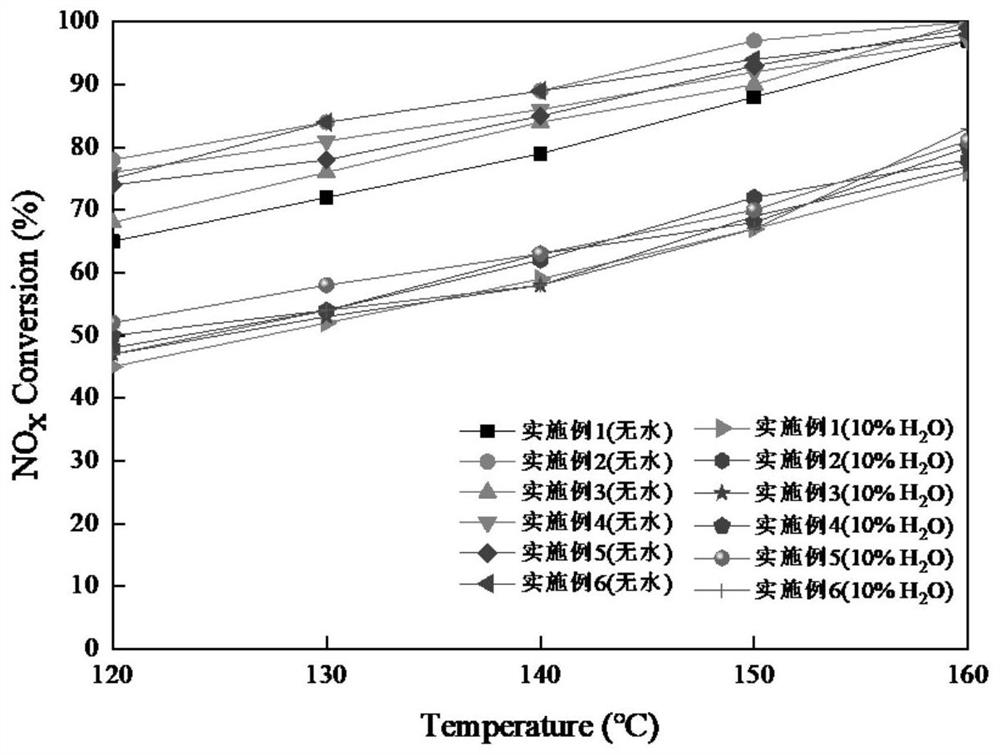A kind of preparation method of low temperature denitration catalyst supported by expanded graphite base carrier
An expanded graphite, carrier-supported technology, applied in chemical instruments and methods, physical/chemical process catalysts, chemical elements of heterogeneous catalysts, etc., can solve the problems of weak interaction, difficult to achieve efficient and stable loading, etc. , Excellent NOx removal efficiency, ensure the effect of water resistance
- Summary
- Abstract
- Description
- Claims
- Application Information
AI Technical Summary
Problems solved by technology
Method used
Image
Examples
Embodiment 1
[0039] A preparation method of a low-temperature denitration catalyst loaded on an expanded graphite-based carrier, the process flow chart is as follows figure 1 shown, including the following steps:
[0040] A. Take an appropriate amount of 200-mesh expanded graphite in a crucible, and bake it at 450°C for 2 hours. The resulting expanded graphite structure is as follows: figure 2 The expanded graphite (EG) loose porous structure shown;
[0041] B, the expanded graphite processed in step A is added to the solution A containing tetrabutyl titanate, ethanol and glacial acetic acid in a volume ratio of 2:8:1 according to the ratio of 1:80.75 to tetrabutyl titanate mass ratio, Sonicate for 15 minutes and then stir for 30 minutes, then add solution C containing ethanol, water and dilute nitric acid (20% by mass) in a volume ratio of 1:1:0.01, which is equivalent to 2 times the volume of tetrabutyl titanate, into solution A , dried overnight at 120°C after standing for 18h and th...
Embodiment 2
[0046] A kind of preparation method of the low-temperature denitration catalyst supported by expanded graphite base carrier, comprises the following steps:
[0047] A. Take an appropriate amount of 200-mesh expanded graphite in a crucible, and bake it at 450°C for 2 hours;
[0048] B, the expanded graphite after processing is joined in the solution B that contains 1% sucrose (mass fraction) first ultrasonic 15min stirs 30min again, then the suspension solution D that is equivalent to solution B 2 times volumes containing titanium dioxide (expanded graphite and Titanium dioxide (mass ratio: 1:19) was added to Solution B, left to age for 18 hours, dried overnight at 120°C and calcined at 450°C for 5 hours to obtain an expanded graphite-based carrier.
[0049] C, manganese salt (manganese acetate), iron salt (ferric nitrate nonahydrate) are dissolved in methanol solution (methanol:water=1:1) according to the mass ratio of 1:1, form metal salt solution after stirring for 30min for...
Embodiment 3
[0053] A kind of preparation method of the low-temperature denitration catalyst supported by expanded graphite base carrier, comprises the following steps:
[0054] A. Take an appropriate amount of 200-mesh expanded graphite in a crucible, and bake it at 450°C for 2 hours;
[0055] B, the expanded graphite processed in step A is added to the solution A containing tetrabutyl titanate, ethanol and glacial acetic acid in a volume ratio of 2:8:1 according to the ratio of 1:420.75 to tetrabutyl titanate mass ratio, Sonicate for 15 minutes and then stir for 30 minutes, then add solution C containing ethanol, water and dilute nitric acid (20% by mass fraction) in a volume ratio of 1:1:0.01 equivalent to tetrabutyl titanate into solution A, After static aging for 12 hours, it was dried overnight at 120° C. and calcined at 450° C. for 4 hours to obtain an expanded graphite-based carrier.
[0056] C. Dissolve manganese salt (manganese nitrate tetrahydrate) and iron salt (ferric nitrate...
PUM
| Property | Measurement | Unit |
|---|---|---|
| particle size (mesh) | aaaaa | aaaaa |
Abstract
Description
Claims
Application Information
 Login to View More
Login to View More - R&D
- Intellectual Property
- Life Sciences
- Materials
- Tech Scout
- Unparalleled Data Quality
- Higher Quality Content
- 60% Fewer Hallucinations
Browse by: Latest US Patents, China's latest patents, Technical Efficacy Thesaurus, Application Domain, Technology Topic, Popular Technical Reports.
© 2025 PatSnap. All rights reserved.Legal|Privacy policy|Modern Slavery Act Transparency Statement|Sitemap|About US| Contact US: help@patsnap.com



